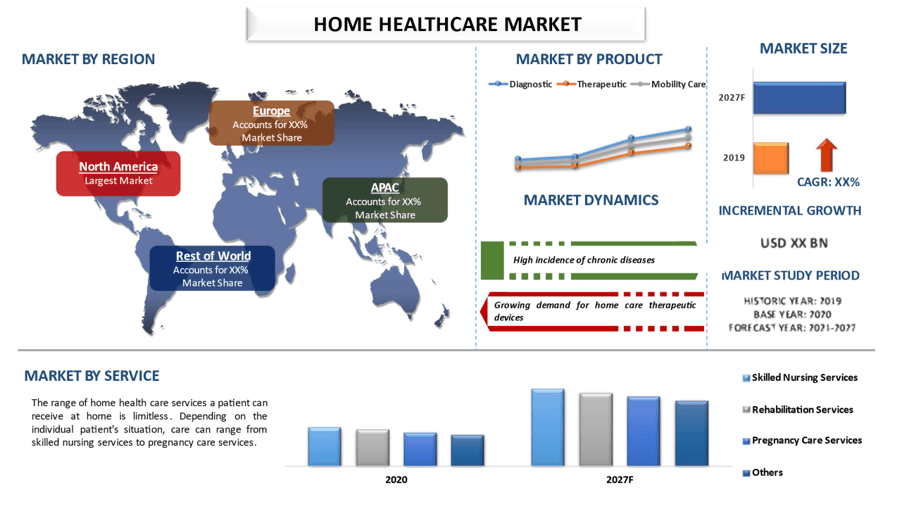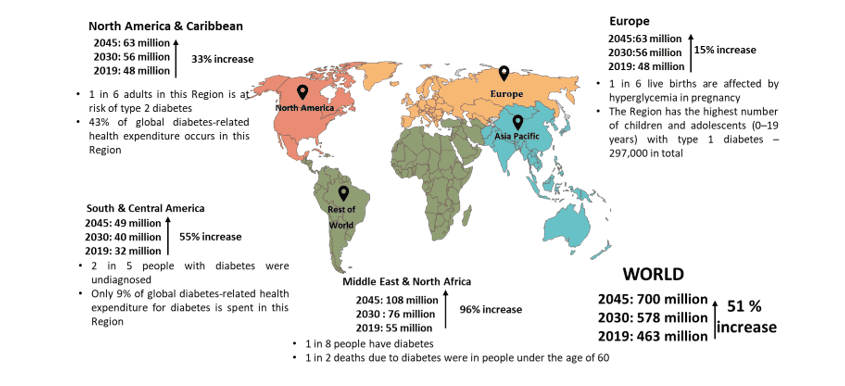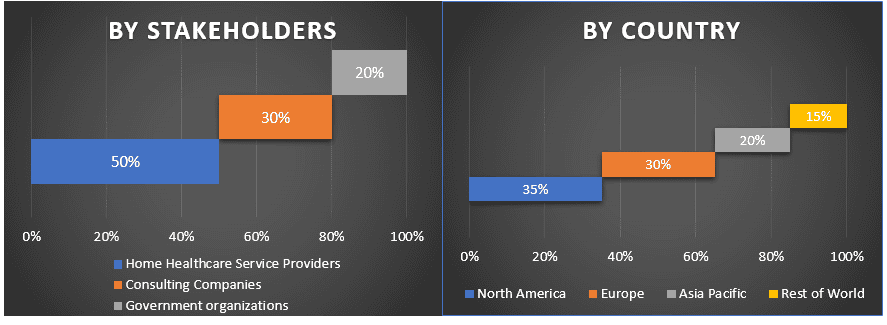- Startseite
- Über uns
- Industrie
- Dienstleistungen
- Lesen
- Kontaktieren Sie uns
Markt für häusliche Krankenpflege: Aktuelle Analyse und Prognose (2021-2027)
Schwerpunkt auf Produkt (Diagnostik, Therapie, Mobilitätshilfe); Service (Qualifizierte Krankenpflege, Rehabilitationsdienste, Schwangerschaftsvorsorge, Sonstige); Indikation (Herz-Kreislauf-Erkrankungen & Bluthochdruck, Diabetes, Atemwegserkrankungen, Schwangerschaft, Mobilitätsstörungen, Hörstörungen, Wundversorgung, Sonstige); Region/Land

KOSTENLOSES MUSTER-PDF ANFORDERN
Es wird erwartet, dass der globale Markt für häusliche Krankenpflege im Prognosezeitraum (2021-2027) eine erhöhte CAGR von ~10 % aufweist
Die Regierungsbemühungen mehrerer Länder, die Einrichtung von Telemedizin und Telehealth, definierte Erstattungsrichtlinien und ein rechtlicher Rahmen für Telehealth-Praktiken verstärken das Marktwachstum. Beispielsweise kündigten die Centers for Medicare & Medicaid Services (CMS) im April 2019 Änderungen in der Telehealth-Politik von Medicare an und finalisierten diese, um die Fernüberwachung von Patienten zu ermöglichen, damit diese auf die neueste Technologie zugreifen und die Koordination der Gesundheitsprozesse verbessern können.
Die zunehmende Verbreitung von Krankheiten in Verbindung mit der steigenden Zahl älterer Menschen trägt zum wachsenden Markt für häusliche Krankenpflege bei. Im Jahr 2019 belief sich die Weltbevölkerung der Menschen ab 65 Jahren auf 703 Millionen. Im Jahr 2050 wird erwartet, dass die Zahl der älteren Menschen auf 1,5 Milliarden ansteigen wird. Der Anteil der Weltbevölkerung ab 65 Jahren stieg von 6 % im Jahr 1990 auf 9 % im Jahr 2019. Bis 2050 wird erwartet, dass dieser Prozentsatz auf 16 % steigen wird. Die häusliche Krankenpflege ist eine kostengünstige Alternative zu einem teuren Krankenhausaufenthalt. Steigende Behandlungskosten sind eines der Hauptanliegen von Regierungen und Gesundheitsorganisationen, und daher sind sie bestrebt, die Gesundheitskosten einzudämmen. Gemäß einem Bericht des Commonwealth Fund ermöglichen „Hospital at Home“-Programme Patienten, zu Hause eine Akutversorgung mit weniger Komplikationen und einer Kostenreduzierung von über 30 % zu erhalten.
Anzahl Erwachsener (20–79 Jahre) mit Diabetes weltweit, 2019, 2030 und 2045

McKesson Medical-Surgical Inc., Fresenius Medical Care, Medline Industries, Inc., Medtronic PLC, 3M Healthcare, Baxter International Inc., B. Braun Melsungen AG, Arkray, Inc., F. Hoffmann-La Roche AG, Becton usw. sind einige der prominenten Akteure auf dem Markt für häusliche Krankenpflege. Mehrere Fusionen und Übernahmen sowie Partnerschaften wurden von diesen Akteuren eingegangen, um Kunden mit innovativen Produkten zu unterstützen.
Im Bericht dargestellte Einblicke
„Unter den Produkten wird das therapeutische Segment einen beträchtlichen Marktanteil erobern“
Basierend auf dem Produkt ist der Markt in Diagnostik, Therapie und Mobilitätspflege unterteilt. Das Diagnostiksegment eroberte im Jahr 2020 einen Marktanteil von XX %. Die zunehmende Verbreitung von Krankheiten aufgrund der steigenden Zahl älterer Menschen, des steigenden Verschmutzungsgrades usw. tragen ebenfalls zum wachsenden Markt für Diagnostik bei. Darüber hinaus wird das Therapeutiksegment in den kommenden Jahren eine beträchtliche CAGR verzeichnen.
„Unter den Dienstleistungen dominierte das Segment der qualifizierten Pflegedienste im Jahr 2020 den Markt“
Basierend auf den Dienstleistungen ist der Markt in qualifizierte Pflegedienste, Rehabilitationsdienste, Schwangerschaftsbetreuungsdienste und andere unterteilt. Das Segment der qualifizierten Pflegedienste eroberte einen Marktanteil von XX % und dominierte den Markt im Jahr 2020. Die Nachfrage nach qualifiziertem Pflegepersonal entsteht hauptsächlich bei älteren Menschen. Der Mangel an Pflegepersonal ist jedoch ein großes Marktwachstumshindernis für dieses spezielle Segment. Laut der American Healthcare Association gaben 94 % der Pflegeheimanbieter an, dass sie im letzten Monat einen Personalmangel hatten. In betreuten Wohneinrichtungen gaben 81 % an, dass sie ähnliche Personalengpässe hatten.
HOLEN SIE SICH EIN KOSTENLOSES MUSTER
„Unter den Indikationen wird Diabetes einen beträchtlichen Marktanteil erobern“
Basierend auf der Indikation ist der Markt in Herz-Kreislauf-Erkrankungen und Bluthochdruck, Diabetes, Atemwegserkrankungen, Schwangerschaft, Mobilitätsstörungen, Hörstörungen, Wundversorgung und andere unterteilt. Das Diabetessegment eroberte im Jahr 2020 den Marktanteil von XX %. Das Segment der Herz-Kreislauf-Erkrankungen wird jedoch in den kommenden Jahren eine beträchtliche CAGR verzeichnen.
„Nordamerika stellt einen der größten Märkte für den Markt für häusliche Krankenpflege dar“
Für ein besseres Verständnis der Marktakzeptanz des Marktes für häusliche Krankenpflege wird der Markt basierend auf seiner weltweiten Präsenz in den Ländern wie Nordamerika (die Vereinigten Staaten und Kanada), Europa (Deutschland, Frankreich, Italien, Spanien, Vereinigtes Königreich und das übrige Europa), Asien-Pazifik (China, Japan, Indien, Australien und das übrige APAC) und der Rest der Welt analysiert. Die Region Nordamerika eroberte XX % des Marktes für die häusliche Krankenpflege und generierte im Jahr 2020 einen Umsatz von XX Millionen USD. Die Region Asien-Pazifik wird jedoch in den kommenden Jahren die höchste CAGR verzeichnen.
Gründe für den Kauf dieses Berichts:
- Die Studie beinhaltet eine Marktdimensionierungs- und Prognoseanalyse, die von authentifizierten wichtigen Branchenexperten validiert wurde
- Der Bericht bietet einen schnellen Überblick über die Gesamtleistung der Branche auf einen Blick
- Der Bericht umfasst eine eingehende Analyse prominenter Branchenkollegen mit einem primären Fokus auf wichtige Finanzdaten des Unternehmens, das Produktportfolio, Expansionsstrategien und die jüngsten Entwicklungen
- Detaillierte Untersuchung der Treiber, Einschränkungen, wichtigsten Trends und Chancen, die in der Branche vorherrschen
- Die Studie deckt den Markt umfassend über verschiedene Segmente hinweg ab
- Tiefgreifende regionale Analyse der Branche
Anpassungsoptionen:
Der Markt für häusliche Krankenpflege kann gemäß den Anforderungen oder einem anderen Marktsegment weiter angepasst werden. Darüber hinaus versteht UMI, dass Sie möglicherweise Ihre eigenen geschäftlichen Anforderungen haben. Zögern Sie daher nicht, sich mit uns in Verbindung zu setzen, um einen Bericht zu erhalten, der Ihren Anforderungen vollständig entspricht.
Inhaltsverzeichnis
Forschungs-Methodik für die globale Marktanalyse für häusliche Krankenpflege (2021-2027)
Die Analyse des historischen Marktes, die Schätzung des aktuellen Marktes und die Prognose des zukünftigen Marktes für den Markt für häusliche Krankenpflege waren die drei wichtigsten Schritte, die unternommen wurden, um die Nachfrage nach häuslicher Krankenpflege in den wichtigsten Regionen zu schaffen und zu analysieren. Es wurden umfassende Sekundärrecherchen durchgeführt, um die historischen Marktzahlen zu sammeln und die aktuelle Marktgröße zu schätzen. Zweitens wurden zahlreiche Erkenntnisse und Annahmen berücksichtigt, um diese Erkenntnisse zu validieren. Darüber hinaus wurden umfassende Primärinterviews mit Branchenexperten entlang der Wertschöpfungskette des Marktes für häusliche Krankenpflege geführt. Nach der Annahme und Validierung der Marktzahlen durch Primärinterviews verwendeten wir einen Top-Down/Bottom-Up-Ansatz, um die gesamte Marktgröße zu prognostizieren. Danach wurden Marktaufschlüsselungs- und Datentriangulationsmethoden angewendet, um die Marktgröße von Segmenten und Untersegmenten der Branche zu schätzen und zu analysieren. Die detaillierte Methodik wird im Folgenden erläutert:
Analyse der historischen Marktgröße
Schritt 1: Eingehende Untersuchung von Sekundärquellen:
Es wurde eine detaillierte Sekundärstudie durchgeführt, um die historische Marktgröße der häuslichen Krankenpflege aus unternehmensinternen Quellen wie Jahresberichten & Finanzberichten, Performance-Präsentationen, Pressemitteilungen usw. und externen Quellen wie Fachzeitschriften, Nachrichten & Artikeln, Regierungsveröffentlichungen, Wettbewerberveröffentlichungen, Sektorberichten, Datenbanken von Drittanbietern und anderen glaubwürdigen Veröffentlichungen zu erhalten.
Schritt 2: Marktsegmentierung:
Nachdem wir die historische Marktgröße des Marktes für häusliche Krankenpflege erhalten hatten, führten wir eine detaillierte Sekundäranalyse durch, um historische Markteinblicke und Marktanteile von Produkten, Dienstleistungen und Indikationen für wichtige Regionen zu sammeln. Die wichtigsten in dem Bericht enthaltenen Segmente sind Produkt und Indikation. Darüber hinaus wurden Analysen auf regionaler und Länderebene durchgeführt, um die allgemeine Akzeptanz der häuslichen Krankenpflege weltweit zu bewerten.
Schritt 3: Faktorenanalyse:
Nachdem wir die historische Marktgröße verschiedener Segmente und Untersegmente erfasst hatten, führten wir eine detaillierte Faktorenanalyse durch, um die aktuelle Marktgröße der häuslichen Krankenpflege zu schätzen. Darüber hinaus führten wir eine Faktorenanalyse mit abhängigen und unabhängigen Variablen wie der zunehmenden Prävalenz von Krankheiten, der steigenden alternden Bevölkerung usw. durch. Es wurde eine gründliche Analyse für Angebots- und Nachfrageszenarien unter Berücksichtigung von Top-Partnerschaften, Fusionen und Übernahmen, Geschäftsausweitungen und Produkteinführungen in der häuslichen Krankenpflegebranche weltweit durchgeführt.
WEITERE DETAILS ZUR FORSCHUNGSMETHODIK ANFORDERN
Aktuelle Marktschätzung und Prognose
Aktuelle Marktgröße: Basierend auf verwertbaren Erkenntnissen aus den oben genannten 3 Schritten haben wir die aktuelle Marktgröße, die wichtigsten Akteure auf dem Markt für häusliche Krankenpflege und die Marktanteile der Segmente ermittelt. Alle erforderlichen prozentualen Anteile und Marktaufschlüsselungen wurden mithilfe des oben genannten sekundären Ansatzes ermittelt und durch Primärinterviews verifiziert.
Schätzung & Prognose: Für die Marktschätzung und -prognose wurde verschiedenen Faktoren ein Gewicht zugewiesen, darunter Treiber & Trends, Einschränkungen und Chancen für die Stakeholder. Nach der Analyse dieser Faktoren wurden relevante Prognosetechniken, d.h. Bottom-up/Top-Down-Ansatz, angewendet, um die Marktprognose für etwa 2027 für verschiedene Segmente und Untersegmente in den wichtigsten Märkten weltweit zu erhalten. Die zur Schätzung der Marktgröße angewandte Forschungsmethodik umfasst:
- Die Marktgröße der Branche in Bezug auf den Wert (US$) und die Akzeptanzrate der häuslichen Krankenpflege in den wichtigsten Märkten im Inland
- Alle prozentualen Anteile, Aufteilungen und Aufschlüsselungen von Marktsegmenten und Untersegmenten
- Die wichtigsten Akteure auf dem Markt für häusliche Krankenpflege in Bezug auf die angebotenen Dienstleistungen. Auch die von diesen Akteuren angewandten Wachstumsstrategien, um im schnell wachsenden Markt wettbewerbsfähig zu sein
Validierung von Marktgröße und -anteil
Primärforschung: Es wurden eingehende Interviews mit den wichtigsten Meinungsführern (Key Opinion Leaders, KOLs) geführt, darunter Führungskräfte der obersten Ebene (CXO/VPs, Vertriebsleiter, Marketingleiter, Betriebsleiter, Regionalleiter, Landesleiter usw.) in wichtigen Regionen. Die Ergebnisse der Primärforschung wurden dann zusammengefasst und eine statistische Analyse durchgeführt, um die aufgestellte Hypothese zu beweisen. Die Ergebnisse der Primärforschung wurden mit den Ergebnissen der Sekundärforschung zusammengeführt, wodurch Informationen in verwertbare Erkenntnisse umgewandelt wurden.
Aufteilung der Primärteilnehmer in verschiedene Regionen

Markt-Engineering
Die Datentriangulationstechnik wurde verwendet, um die gesamte Marktschätzung abzuschließen und genaue statistische Zahlen für jedes Segment und Untersegment des Marktes für häusliche Krankenpflege zu erhalten. Die Daten wurden in mehrere Segmente und Untersegmente aufgeteilt, nachdem verschiedene Parameter und Trends in den Bereichen Produkt, Dienstleistung und Indikation des Marktes für häusliche Krankenpflege untersucht wurden.
Hauptziel der Studie zum Markt für häusliche Krankenpflege
Die aktuellen und zukünftigen Markttrends der häuslichen Krankenpflege wurden in der Studie genau bestimmt. Investoren können strategische Erkenntnisse gewinnen, um ihre Entscheidungen für Investitionen auf der Grundlage der in der Studie durchgeführten qualitativen und quantitativen Analyse zu treffen. Aktuelle und zukünftige Markttrends bestimmten die Gesamtattraktivität des Marktes auf regionaler Ebene und boten den Branchenteilnehmern eine Plattform, um den unerschlossenen Markt zu nutzen, um von einem First-Mover-Vorteil zu profitieren. Weitere quantitative Ziele der Studien sind:
- Analyse der aktuellen und prognostizierten Marktgröße der häuslichen Krankenpflege in Bezug auf den Wert (US$). Analysieren Sie auch die aktuelle und prognostizierte Marktgröße verschiedener Segmente und Untersegmente
- Die Segmente in der Studie umfassen die Bereiche Produkt, Dienstleistung und Indikation
- Definition und Analyse des regulatorischen Rahmens für die häusliche Krankenpflegebranche
- Analyse der Wertschöpfungskette mit der Präsenz verschiedener Intermediäre sowie Analyse des Kunden- und Wettbewerberverhaltens der Branche
- Analyse der aktuellen und prognostizierten Marktgröße des Marktes für häusliche Krankenpflege für die wichtigsten Länder
- Die wichtigsten in dem Bericht untersuchten Regionen sind Nordamerika, Europa, der asiatisch-pazifische Raum und der Rest der Welt.
- Unternehmensprofile des Marktes für häusliche Krankenpflege und die von den Marktteilnehmern angewandten Wachstumsstrategien, um im schnell wachsenden Markt zu bestehen
Detaillierte regionale Analyse der Branche
Verwandt Berichte
Kunden, die diesen Artikel gekauft haben, kauften auch










